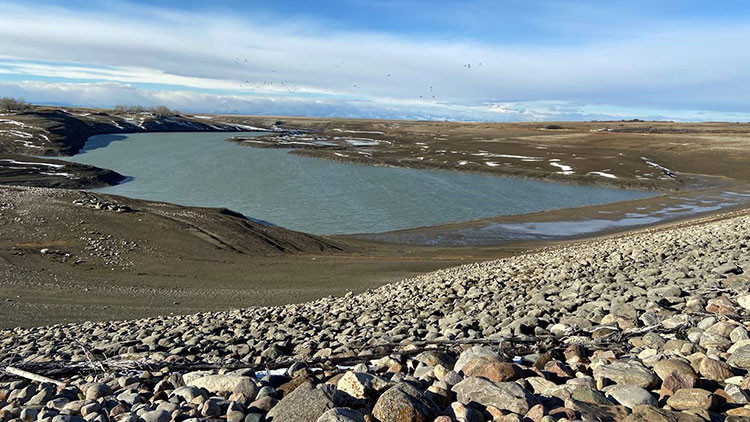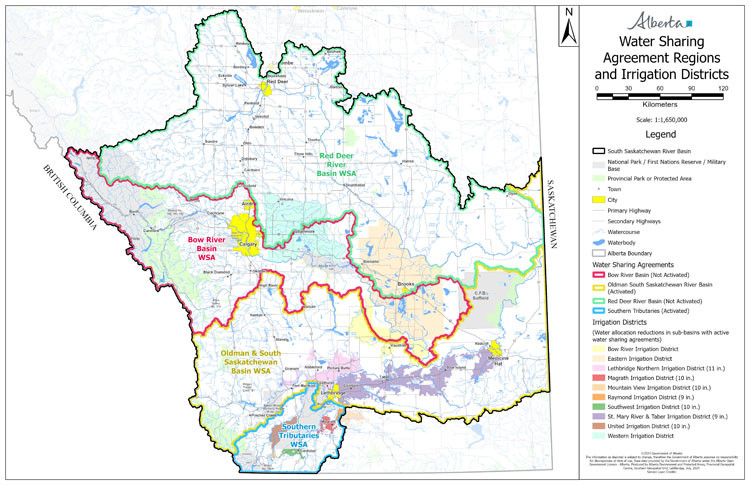Government mail service may be affected by the Canada Post labour disruption. Learn about how critical government mail will be handled.
Water management in Alberta

In Alberta, water management response is shared with:
- the province
- water providers
- regional districts
- municipalities
- Indigenous communities
Although the situation is critical, with proactive water management and working together, we can make the best use of the province’s water supply and increase our chances of being able to meet the needs of all water users.
Expedited processes for drought-related regulatory applications
We recognize that drought conditions may impact a wide variety of water users, including business, the agricultural sector and communities, and we are taking action to help respond quicker to issues caused by drought.
Alberta Environment and Protected Areas (EPA) is now prioritizing regulatory applications related to drought for immediate attention. Applicants can expect to be contacted by an EPA staff member by the next business day if they need an expedited regulatory process due to the impacts of drought.
Prioritization will be given to drought-related applications and processes related to groundwater licences, surface water licences and approvals under the Water Act, and processes that fall under the Environmental Protection and Enhancement Act (EPEA).
See the 2024 drought support fact sheets for more information on expedited processes for drought support.
Licence holder responsibilities during drought
It is the responsibility of the water licence holder to understand and follow the terms and conditions of their licence (for example, rate of diversion, timing, instream flow restrictions, retaining and/or submitting water use records). A water measurement guide is available to help assess your water use – refer to your water licence conditions if you have reporting requirements.
During a water shortage, licence holders gain access to water by any of these 3 methods, or a combination of.
Provincial staff are working with licence holders, major water users and key water partners to support water conservation planning, as required.
Staff from EPA will continue to complete information sharing and compliance verification activities with licensed water users, as needed.
Municipality responsibilities during drought
Municipalities play a large role in water management during drought as they:
- are responsible for water supply and distribution to communities
- develop community-wide water shortage response plans which may include voluntary or mandatory water restrictions
- declare agricultural disasters when crops are impacted by drought
Government officials are meeting with municipal representatives to ensure everyone is prepared and to maximize water usage.
Environment Minister Rebecca Schulz wrote to municipalities asking them to take specific actions to prepare for the risk of severe drought in 2024.
What licence holders and municipalities can do
There are steps that licence holders and municipalities can take to help conserve water and prepare for the risk of severe drought. All water licence holders are asked to familiarize themselves with their licence and its conditions. It is the responsibility of water licence holders to read, understand and comply with their licence conditions related to low flow restrictions.
In addition, it is important that all water licence holders:
- abide by the conditions outlined in their licence
- develop and implement water conservation measures and water shortage plans to help ensure every drop counts
- stay in contact with EPA on monitoring, forecasts and regular updates
Water-sharing agreements
In February 2024, Alberta’s government began meeting with major water users and other key stakeholders in the South Saskatchewan River Basin (Red Deer, Bow, Old Man and South Saskatchewan rivers), to develop voluntary agreements to share water if there’s a severe drought.
- Letter from Minister Schulz to 25,000 water licence holders (sent by mail starting February 1, 2024)
- Letter from Minister Schulz to small water licence holders (April 16, 2024)
On May 9, 2024, the Oldman South Saskatchewan, and Southern Tributaries Water-Sharing Agreements were “activated” and remained activated until October 10. All four water-sharing agreements expired at the end of 2024.
Letters have been sent to affected licence holders, who are non-signatory to the agreements, outlining the specific expectations to match water reductions set out in the relevant water-sharing agreement.
- Notice of Activation of the Oldman South Saskatchewan River Basin Water-Sharing Agreement (sent by email or letter starting May 17, 2024)
- Notice of Activation of the Southern Tributaries Water-Sharing Agreement (sent by email or letter starting May 17, 2024)
- Notice of Irrigation Allocation Increase (sent by email or letter starting July 11, 2024)

South Saskatchewan River Basin Water Sharing Agreement Regions and Irrigation Districts Map with irrigation district allocations, as of June 28, 2024.
If you have questions, contact 403-381-5546 or [email protected].
Find full details on these 'water-sharing agreements' on Drought – what government is doing.
Stay informed on drought conditions
Stay up to date. Follow water shortage advisories and the latest information through:
Sign up to receive a “push notification” if there are advisories in your area.
Resources
- Agricultural moisture situation update [2024]
- Alberta Water Council: Building Resiliency to Multi-Year Drought
- Alberta's Water Act
- Alberta WaterPortal – Drought
- Alberta's Water Priority System: Tools for Water Licence Holders
- Being prepared for water shortage : a guidance document for municipalities
- Canadian Drought Monitor
- Canadian Drought Outlook
- Developing water supplies for agricultural use: water licences and approvals under the Water Act
- Farming in dry conditions
- Move my Licence: Water Act
- Drought support: Expedited Water Act approvals support
- Drought support: Expedited Water Act licence support for groundwater diversions
- Drought support: Expedited Water Act licence support for surface water diversions
- Drought support: Expedited Environmental Protection and Enhancement Act (EPEA) processes
- How to Apply for a Groundwater Temporary Diversion Licence
- How to Apply for a Surface Water Temporary Diversion Licence
- How to Apply for a Condition Revision to a Temporary Diversion Licence
- How to Create and Submit a Groundwater Licence Application
- Preparing Water Shortage Response Plans
- Temporary Diversion Licence (Water Act)
- Water Act: licences
- Water apportionment : how water is shared in the prairie provinces
- Water Act Approval Application – Purpose 'Other'
- Water Diversion for Agricultural Uses During Low Flow Conditions
- Water measurement guidebook
- Working well: clean water. Well protected [2023]
Related
Contact
Connect with Environment and Protected Areas’ Outreach Services:
Hours: 8:15 am to 4:30 pm (open Monday to Friday, closed statutory holidays)
Toll free: 310-3773 (in Alberta)
Email: [email protected]